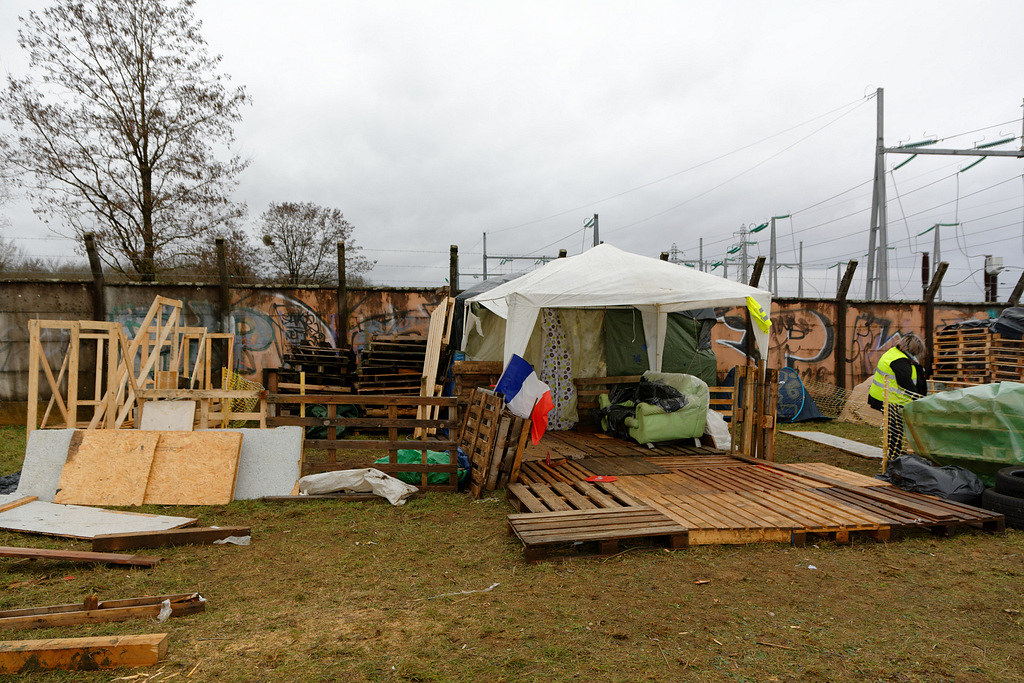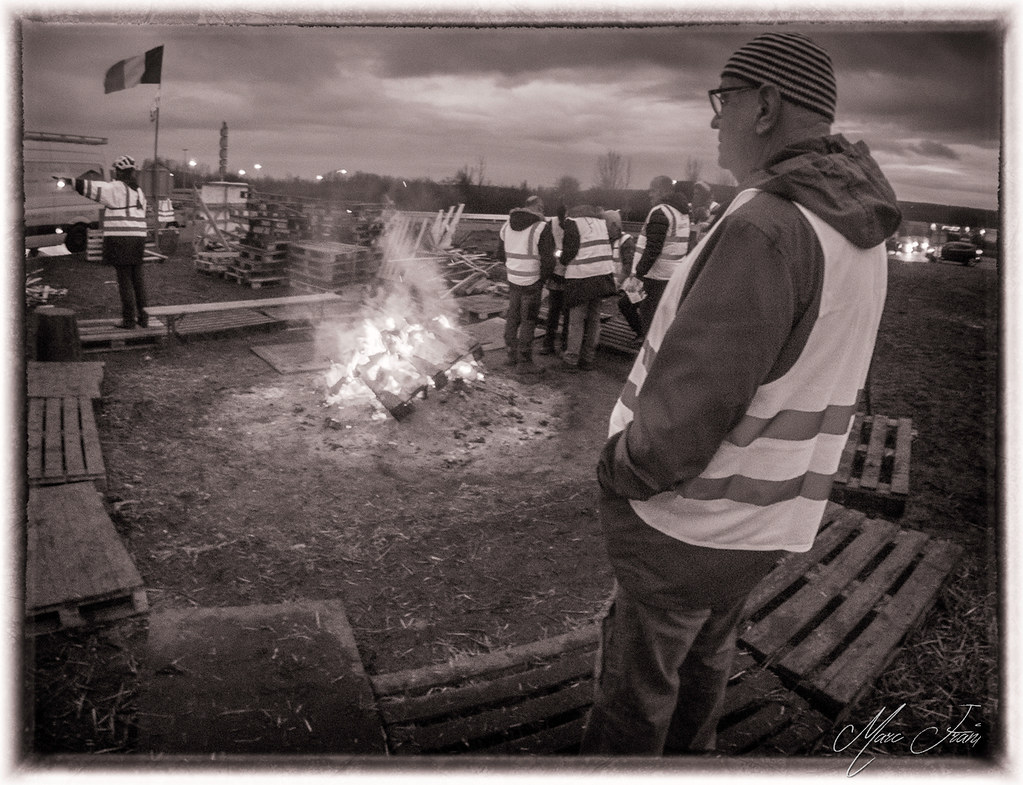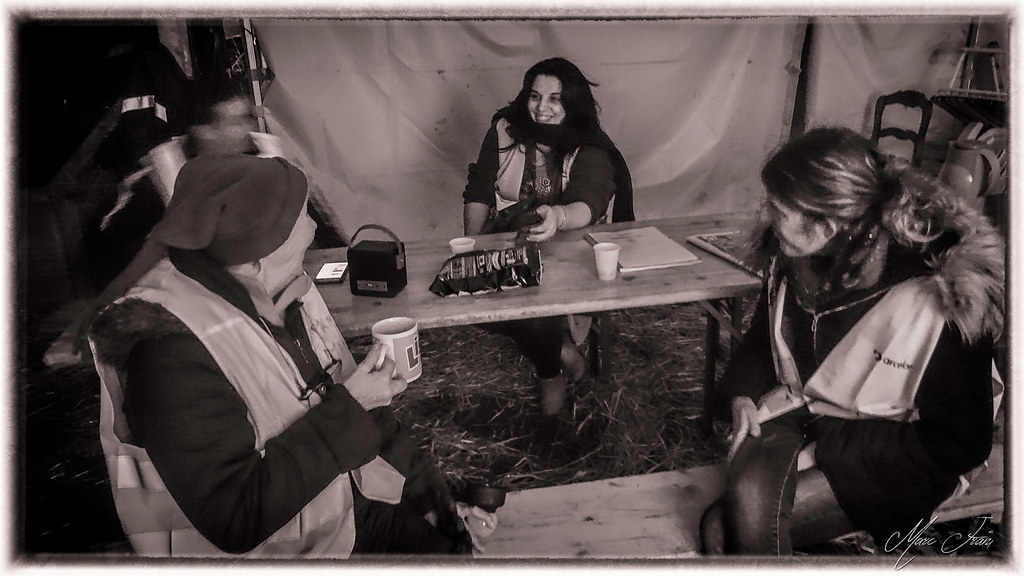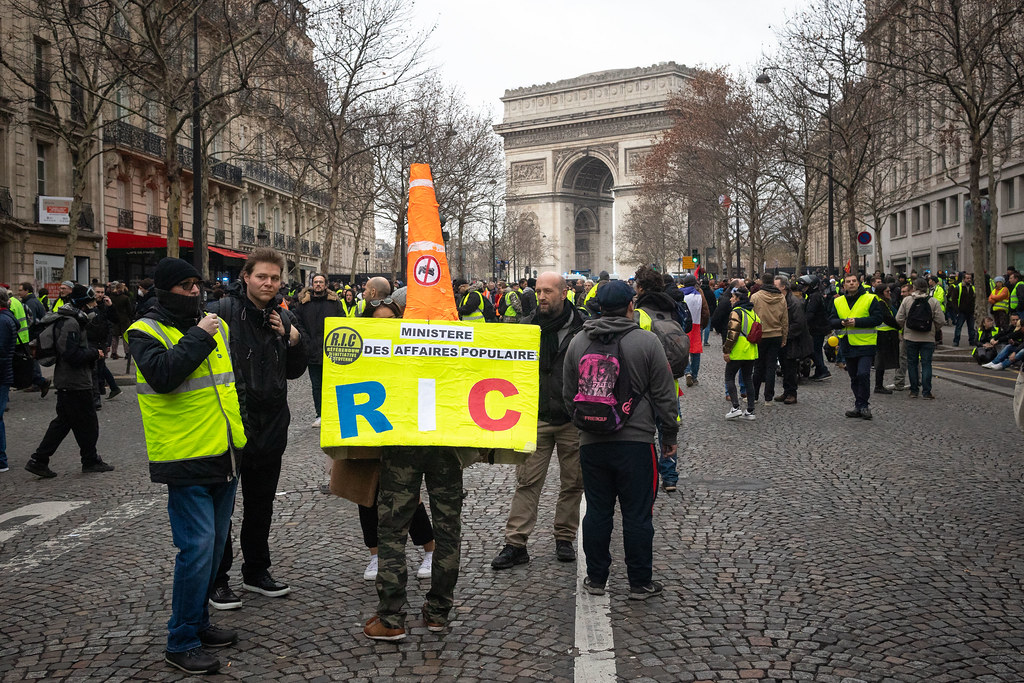“Extraordinary events are beyond the scope of ordinary explanations”
Edgard Morin
Lessons from the Yellow Vests movement in France
by Maxime Combes
“Democracy is not about Saturday afternoons”, French president Emmanuel Macron said, speaking about the Yellow Vests movement (YVM) that have been protesting every Saturday afternoon since November 17, 2018. Such a statement aimed to close the door to any new political, economic or social measures in response to the Yellow Vests mobilisation, just a few days before the European elections on May 26th 2019. While two electoral lists claiming to come from the YVM entered the European Union (EU) election race, Macron invited commentators to assess the political weight of the Yellow Vests: “Now everyone must go to the elections, and, when they have ideas, to stand in the elections. It is much more difficult to propose a project than to be against everything else.”
To this respect, the results of the EU elections are pretty clear: these two lists received just over 260,000 votes, or barely 1% of the votes casted, not enough to get any seat in the EU parliament. The YVM had saturated the political and media agenda, and the streets, for six months, highly supported by most of the population. It has seriously worried Macron himself and the parliamentary majority, to which the government responded with heavy police repression. But the content and results of the EU election campaign could be read as if this movement had no political weight and/or no electoral impacts: many commentators then stated that Macron had provided an adequate political response to the political crisis initiated by the YVM. But, there is no evidence that the social and democratic crisis highlighted by the YVM has been resolved.
The YVM is an unprecedented movement, both in terms of its social composition, its methods and practices, its determination and its duration, and its ability to build a partly favourable initial balance of power opposing Macron and the government. The YVM has been described as a spontaneous mobilisation, not taking root in traditional political parties and social organisations. For many participants, demonstrating or occupying a roundabout was one of the very first political actions of their whole lives. Most of them live in peripheral, peri-urban and rural areas, including a high proportion of women.

They have made roundabouts, these rather bare and dehumanised traffic junctions, the key places of political socialisation and debate as the number and the dynamism of public spaces have greatly shrunk. Those who we were not used to seeing in social movements, and in the political field, made a double demonstration. Not only did they created their own political space, but they also extended their demands far beyond sectoral concerns, galvanizing their movement around the imperative of systemic economic, social and political transformations. This is one of the major achievements of this movement: from a sectoral demand – being in the streets against the increase in carbon taxes and fuel prices – to fully articulate the economic, social and political issues people are facing.
That is why president Macron and his government tried to shut down these debates reducing the issue to a narrow democratic practice: voting at the EU elections. However, the movement had widely deeply renewed the debate on the future of our (supposedly) democratic political regime: how it should work? How decisions should be taken? How to hold politicians accountable? What should be the role of the elites? How people can take control over policy decision making and over the economy? How to democratise democracy? How to make democracy work better between two elections? Through a short radiography of the YVM, this article aims to see how this movement has profoundly questioned the French democratic regime, but also the social movements and the political left through their modes of action and proposals aimed, in particular, at deeply democratising democracy.
Early days: roundabouts and yellow vests make invisible people politically visible
The YVM began on November 17th, 2018 with an occupation of roundabouts and street demonstrations involving more than 280,000 people over a large part of the country. One year later, the Yellow Vests have been demonstrating in the country for 53 consecutive Saturdays. This is unheard of: never before has a citizens’ movement have sustained weekly demonstrations for an entire year, often decentralised in dozens of cities. According to Ministry of Interior figures, the number of people in the streets has decreased to just over 30,000 by the end of 2018. Many commentators thought that the movement would have packed up and not come back after the winter holidays. In January 2019, everything should have been over. This has not been the case. Nearly 90,000 people were in the streets and some of them never stopped: over the weeks, they were representing between one-tenth and one-twentieth of the inaugural mobilisation, according to ministerial figures.
The roundabouts were at the same time a back base, a decentralised HQ and a meeting place where everyone can find something to do. From the beginning of the movement, they have not only blocked roundabouts, slow traffic flows or prevent access to commercial areas. On or near these roundabouts, on private land made available to them, they settled up huts, tents, fences, barbecues, braziers, and in some cases rudiment installations for cooking, hosting people, organising movie screening, public debates etc. They have transformed roundabouts, those soulless non-places, where cars only pass through, into public squares, allowing people to fraternise and to take decisions and to engage in a collective political process.
The urban planner Eugène Hénard (1849-1923) who made the first roundabout in history, around the Arc de Triomphe in Paris, would never have thought that people wearing a yellow vest would have used hundreds of the country’s 30,000 roundabouts – a world record – to transform them into political gatherings for the mass. Nor would the legislator thought that the fluorescent yellow roadside emergency vests, which is mandatory to have in cars, could become the symbol and the colour of the country’s most important popular insurrection in recent years.

Displayed initially on the dashboards of the vehicles, the yellow vest was a sign of rallying and solidarity. On roundabouts and in demonstrations, worn on the shoulders, the yellow vest has become a banner where a slogan, a demand or a political message is written. The vest wasn’t just making people visible on side roads in case of emergency, it was making them politically visible every day and everywhere: the invisibles of daily life were now visible on TV. The yellow vests allow both unity and distinction: people all wear the same clothing, a cheap and easy to find, but everyone can stand out and be original with a specific message written on it.
The roundabouts and yellow vests were surely a material condition for the rapid expansion of the movement: everyone has a yellow vests in the car and on a roundabout near home. In almost a year, more than 50,000 demonstrations and rallies have been counted by state institutions across the country. If the images of the riots in Paris have struck people’s minds, the YVM is before all a deeply decentralised movement rooted in the territories. If the Arc de Triomphe has become the epicentre of a revolt taking place in the bourgeois districts of Paris, the experience of many Yellow Vests was first and foremost the collective and local initiatives on the roundabouts next to their homes.
Looking at the forms of mobilisation in the heart of Paris, and more broadly in French big cities is also a way to take into account how the YVM is changing the way to organise citizens mobilisations. From December 1, 2018, these were the symbols of national power that were targeted: the Elysee, where the president’s office is located, and the ministries in the capital, and the prefectures in the rest of France. Even smaller provinces, like Le Puy (Haute-Loire), demonstration took place around the local prefecture. To take up the sociologist Charles Tilly’s categories of mobilisation, the YVM is a kind of national and autonomous movement, using a repertoire of action typical of the social and political mobilisations of modernity (Tilly, 1986).
The YVM is not a “jacquerie” – peasants revolt in the Medium Age – as some commentators have said to most often undermine their credibility. At the same time, the Yellow Vests modalities of action differed from traditional leftist political or trade union mobilisations. The first demonstrations were not declared in the prefecture and organisers had no legal representatives. Moreover, these demonstrations took unusual forms: people walked without being attached to a clearly identified block, there were no banners or leaflets distributed during the marches, and, there was no group of activists in charge of ensuring collective security. From this point of view, the YVM therefore embodies both continuity (targeting the State and the government) and a break with traditional social mobilisations.
Out of the conventional pathways
In December 2018, more than one in five French people declared themselves to be “yellow jackets”, expressing massive support for a decentralised citizens’ movement: this is not a convergence of existing struggles, but the convergence of invisible people who were not already mobilised. The sociological surveys carried out at that time indicated that the participants are mainly people who have a job but are struggling to make ends meet: they are impoverished salaried workers or self-employed people whose living conditions are deteriorating (insufficient income to cope with constrained expenses, poor quality housing, etc.). They hunt down the lowest prices to buy food, and even more so to get dressed. Seven out of ten yellow jackets even admit to having postponed or given up medical care! Craftsmen and shopkeepers are over-represented, while managers are under-represented. The proportion of women (almost one in two) is significant: all observers noted their very strong presence, especially single women with children.
Most of the people thought that this movement would last only a few days. The media had few journalists on the ground and it is more or less the same for most of leftist organizations. Those ready to mobilise against the increase in carbon taxes on fuels did not belong to the traditional political organisation, trade union or or non-profit organizations. When the invisible and inaudible can no longer cope with their social situation and are preparing to engage in a social movement, they remain politically invisible. It was only when their calls to demonstrate on November 17th brought together hundreds of thousands of “interested” people on social media and, above all, when thousands of them gathered on roundabouts that day, that their became visible. But most of the political and media elites did not have all the intellectual and social tools to understand what was going on.
The YVM is one of the very first social movements of this magnitude in France in recent history, which makes visible and supports the interests of social groups who no longer felt represented in traditional political or trade union organisations. As in many other countries, political and social disintermediation is at its height: traditional mediations such as unions, political parties, and even citizen associations are bypassed by emerging movements. These latter even destabilise them by using social networks and ad hoc platforms to organise themselves outside of traditional frameworks. The YVM clearly reflects the loss of influence of traditional organisations and the weakening of their social roots. Those who are invisible or denied, no longer accept to be organised and mobilised by those who are already (even a bit) visible or who have a social and political status.
The YVM has spread beyond the usual suspects: social networks were key factors to informally structured their movement. This is undoubtedly one of the reasons for its quick and impressive expansion: people were joining a citizen movement, not an organisation. Participants were invited by their friends, their peers, through Facebook pages, not by a union or political leaders through a leaflet and/or the media. People were invited to reach an accessible place, close to home, with a piece of clothing they had already in the car. It was not about joining a political meeting or a union demonstration for which they don’t have the codes. The YVM is iconic in the sense of what sociologist Albert Ogien calls the “autonomous political practices” that develop away from the traditional institutions of representative democracy (Ogien, 2019).
From roundabouts to the challenging collective organisation
The roundabouts become real small agoras where people come to meet, discuss, confront, live and act together, among fellow citizens, isolated workers and lonely individuals looking for some solidarity in action, not just words. Trust is thus built on the basis of shared experience and is not given to distant and uncontrollable media figures, much less to a charismatic personality who would lead the movement. In the YVM, there is no single leader, no decision-making headquarters. Internet and social networks increase the mobilisation capacities of the Yellow Vests tenfold and serve as a technical device to allow the organisation and coordination of the movement. Social networks have broadened their audience before media attention and they were used as a sounding board once the media began to follow the movement. They tend to function as powerful vectors of protest diffusion, allowing people who don’t know each other to connect in a form of immediacy and as a way to aggregate slogans / claims without having to eliminate some of theirs.
The YVM is a hybrid form of a nation-wide movement rejecting any kind of representation and delegation to retain decision-making power on roundabouts. But the Yellow Vests participants also accept that mobilisation calls could be widespread on social networks, without being, for most of them, included in the decision-making process. Since November 17th, 2018, despite several attempts to “coordinate” the YVM, none have been fully successful and no stabilised organisational rules were set up. Following media invitation and/or the increase of influence on social media for some of them, a dozen of Yellow Vests were seen, at some moment, as spokespersons for the movement. But most of them decided not to play this role, distancing themselves from the label of “Yellow Vests leader”. Media, public authorities and social organisations never found spokespersons in capacity to represent the whole movement.

However, the survey among Yellow Vests participants in the North-West Seine-Maritime region shows that 91% of respondents want to structure themselves into an organised and sustainable movement, and that 80% think that spokespersons are needed to represent them (Dormagen/Pion 2018). But the practical question of how to do this has not been resolved. The most advanced coordination process is precisely based on the rejection of representation and the rejection of hierarchy and delegation. “We don’t want representatives who would inevitably end up speaking for us!” stated[1] the Yellow Vests group of Commercy, calling for popular assemblies all over the country. The first Assembly of Assemblies took place in Commercy in January 2019 and the democratic question of the movement’s representation stayed as a main issue in the movement. This assembly of assemblies will then meet twice (Saint-Nazaire in April, Montceau-les-Mines in June) until the meeting in Montpellier in early November 2019, which brought together nearly 500 delegates chosen by the 200 local groups.
The YVM have come up against the constraint of political representation in the current representative democratic framework. They were successful in imposing their own issues in the public debate, but also their unique and unprecedented rallying points and symbols. At the same time, the YVM showed how traditional action repertoires and traditional political channels are maybe inappropriate. But the movement has not been able to overcome this powerful and rigid framework. The “Roundabout Democracy” has come up against traditional representative democracy. The poor results of the two Yellow Vests lists to the EU elections is only a small part of a much bigger challenge. At a time of individualisation of social despair, the mediation taking place on roundabouts and the Saturday afternoon marches are undoubtedly an incredible political experience but they might still be a little short to revolutionise the French political regime. In the short-term at least.
Behind the carbon tax, a deep sense of injustice and a yearning for a better democracy
For years, social movements have unsuccessfully been trying to put the social issues back at the heart of public debate. The Yellow Vests did. Better still, while they were initially presented as anti-ecological people who don’t care to burn the planet because they were saying “No” to carbon tax increases, they instead turned the question upside down pointing out the necessary link between social justice and ecological justice which necessarily relates to democracy. It wasn’t easy: one of the very first and consensual demand was clearly to urge the government to abandon the planned increase in the carbon tax. Many environmentalists feared that this movement would be nothing more than a mobilisation against ecological policies. In short, the movement was depicted as yearning for the right to pollute in peace without paying any taxes. Some conservatives and libertarian forces supported the very first days of mobilisation for this reason: to strengthen a “no tax” movement in France. But they quickly disillusioned and stopped supporting the movement in contrast to the left-wing social, ecologist, trade union and political organisations which, after much hesitation, tried to support and interact with the YVM.[2] It was never easy, but it probably contributed to this programmatic work that led the YVM to broaden their demands and ultimately focus on democracy..
The government has done everything it could to defend the carbon tax and explain how it was needed regarding the climate crisis. It is in the name of “ecological transition” and the need to “liberate households from dependence on petrol” that French Prime Minister justified the French carbon tax and the increase in its amount over the years. Their discourse is intended to be simple and accessible: by increasing the prices of fuels, consumers can modify their behaviour, reducing their use of vehicles and/or buying more fuel-efficient vehicles. The same applies to boilers that use oil, in which case people are supposed to replace them in favour of wood-burning or gas boilers. The case of tobacco is often used as an example: hasn’t its increase in price, done in the name of public health, reduced its consumption?
But people didn’t believe in this promise. First, the poorest do not have the money and the capacity to change their own behaviour since they carry too many “pre-committed” expenditures. Secondly, they know the richest pollute the most and big corporations can pollute in total impunity, without paying the level of taxes they should (Combes 2018). Thirdly, the carbon tax reinforces social and economic inequalities. And finally, the carbon tax increase was not intended to finance an ecological transition but rather, to pay for the tax cuts (wealth tax, capital tax, dividend tax, corporate tax, etc.) that president Macron granted to the richest and big corporations. Since the carbon tax was not matched with policies to reduce transportation and heating needs, focusing on individual changes, the government policies prevent to address the root causes of the gargantuan dependence on fossil fuels.
Even at the beginning of the YVM, it was not a “no-tax” slogan that was waved, but a deep sense of injustice that was being expressed. How can a policy of raising fuel prices for households be justified when companies are either exempted from these increases – in particular in air and maritime transport – or hardly affected by the very weak increase in the price of carbon in the European carbon market such as the French oil company Total, cement and steel plants?
Dignity for the invisibles …
Looking at the different lists of claims the Yellow Vests have published[3], whether they were established locally or through virtual processes, can lead to very different analysis. It is the very conception of a democratic model and democratic debate that is at stake: which people should decide and on whose principles . There is one that consists in analyzing them under the prism of what is already agreed in social movements or in the left. Leftist activists will focus on the texts and studies showing that a set of demands is almost unanimously supported : increase in the minimum wage, reinstate of a wealth tax, increase in pensions are for example supported by 90% of the respondents of a research (Dormagen / Pion 2018). That’s not wrong, but not enough accurate. These lists include much more claims than social ones. If you widen the scope, you can only see a “magma of heterogeneous demands.”[4] For example, some measures to improve the living conditions of the poorest people go hand in hand with proposals to restrict migrants rights. While demanding an end to the closure of small train lines, post offices, schools and maternity wards, more resources are asked to fund the police and the army, which are not at all what the political and social left agrees on.

Another option is to look at the Yellow Vests demands for what they are and to try to identify which are the remarkable features, if they have. Historian Samuel Hayat tried to carry out this work (Hayat 2018). Hayat stated that these lists of revendications “are deeply coherent, and that what gives coherence is also what has enabled the mobilisation of Yellow Vests to happen and to last: it is anchored in what can be called the moral economy of the working classes.” For him, a Yellow Vests slogan perfectly sums up this coherence: “Let the BIG ones (McDonalds, Google, Amazon, Carrefour…) pay BIG and the small ones (craftsmen, very small SMEs) pay small”. In other words, the most vulnerable must be protected, those who work must be properly paid, public services must work, tax evaders and those who take advantage of their status must be punished.
Hayat borrows the well-known concept of “moral economy” from historian E. P. Thompson to designate widely shared conceptions of what a moral functioning of the economy should be (Thompson 1976). Therefore, claims about foreigners or non-nationals should no longer be seen as “slag that could easily be discarded.” For Hayat, [these demands] “they are at the heart of the movement (…) because it is the logical consequence of the implementation of a moral economy that is first and foremost communitarian.”“The moral economy is the proclamation of a community’s standards,” he continues, and “the logic of equal rights is not extended to foreigners”, nor does such an approach recognise ideological conflict. Hayat explains that “the partisan nature of democracy, the opposition between political projects” is rejected, in favour of seeking a unity of position that indeed excludes those who are not already part of the community. Not because it makes economic sense, but because it is morally right.
By requiring that the economy be based on moral principles, the YVM gains massive support among the population: it sets out as intangible principles demands for dignity that the government, and president Macron in particular, have denied and mocked for months. The government has never ceased to attack explicitly these moral economy principles. To counteract the movement, President Macron has organized his very own National Debates Dialogues, a two-month consultation across the country but the initiative quickly backfired at the executive. A citizen speaking during one of these debates summarized the mood: “I live on 900 euros a month, but that’s not what made me be part of the Yellow Vests… One night, when I was washing dishes, I heard President Macron talking about “people who are nothing”. Such words were so outrageous! When you don’t have much, you still have your dignity. And Macron took away our dignity. Why such a violence!”
… and democracy for all
Setting up a short genealogy of the Yellow Vests evolution of demands might help us to better understand why yearning for a better democracy quickly took up much more space in the movement. This movement was fundamentally not fuelled by the simple rejection of taxes and it was not compartmentalising demands: social demands on the one hand, ecological demands on the other, and, besides them, demands for democratising democracy. Macron’s contempt for “people who are nothing” is undoubtedly one of the real catalyst of the movement. Given that it comes at a time of great mistrust towards politicians, on whatever political side, but also at a time where the feeling of ineffectiveness of trade unions and associations is widely widespread, the YVM is looking for an autonomous strategy that could overcome these challenges all together. The claims the Yellow Vests presented as consistent with each other, seek both to restore dignity and give them back real control and decision-making power over their own lives, politics and the economy.
In a way, the YVM may be seen in the direct continuity of what the Occupy movements have expressed for the last eight years: together, or rather one after the other, “they took note of the bankruptcy of representative politics” and aspire to “self-representation” (Balibar 2019). Self-representation is “the presence of citizens in person in the public square.” “You don’t represent us” shouted the Indignados and Occupy Wall Street (2011 to 2013), or even the French uprising Nuit Debout (2015) to take away any legitimacy from all political representatives. In the case of YVM, this is particularly true: there are no more members of parliament belonging to the worker’s class in the French National Assembly and less than 5% of the deputies were employees.The Yellow Vests are coming from a deep rejection of representative governments and are searching for radical democratic alternatives.
The Yellow Vests demands related to democracy can be divided into three main groups:
- a better representation (proportionality to elections, etc.);
- a better control and accountability of elected representatives, their activity, the resources they are given (lower wages, strict control of their expenditures, regulations against lobbying, right to recall elected officials, etc.);
- a radical transformation of democracy with, among others, referendum on citizens’ initiatives, citizens’ assemblies, etc.)
In a way, these requests are a twofold movement: making sure that those who “benefit” from this system of representation be forcibly brought back into the “collective community” and “live like everyone else.” In other words, that would mean the end of privileges for the 1%, the elites. And on the other hand, to ensure that those who are deprived of access to decision-making spaces can take back control over them. To the deep mistrust towards representation that has led to the fact that the 1% are governing for themselves, the YVM responds with a set of demands that aim to make sure that those at the bottom will have the right to decide their common future.
The mistrust towards the elites and the demands to be heard and to be considered as a citizen are not new. What is new is that they are no longer only carried by the usual suspects: these are the working classes who make this request, and who do so directly, without the mediation of a party or a trade union. During the Nuit Debout movement, the radical demand for participation, which was expressed in the form of direct democracy, was coming from another category of the population, rather the urban and educated middle class. In France, such a massive demand from invisible and marginalized population has probably never been expressed so forcefully since the revolutions of 1789 or 1848. In a sense, we find here Lenin’s famous phrase that pre-revolutionary situations arise when those at the top can no longer govern as before, and those at the bottom no longer want to be governed as before. This is clearly the situation expressed by the YVM. Concluding that a democratic revolution is about to happen would be to take one of the options on the table as the only one possible.
The RIC: a dead end or the beginning of the end of democracy captured by elites?
Having a closer look at the debate around the Citizens’ Initiative Referendum (RIC), one of the main Yellow Vests demand, may provide a better understanding of the challenges faced by traditional social and political movements. The RIC is a direct-democratic system that allows citizens to convene a referendum without the consent of the parliament or the head of state being required. Several of these types of referendums are used at the national level in about 40 countries including Switzerland, Italy, Slovenia or Uruguay, as well as at the regional or local level in some countries (United States or Germany). Such a proposal is deeply contradictory to the French political system which is a very presidential and a vertical one. The Yellow Vests proposal generally includes four modalities: voting on a bill (legislative referendum); repealing a law passed by Parliament or a treaty (repeal referendum); amending the Constitution (constitutional referendum); revoking an elected representative (repeal referendum). This demand embodies the deep crisis of representative democracy observed in many countries.
In France, surveys indicate very strong people support for the RIC. The Yellow Vests are promoting the RIC as a way to pass on all their demands directly, without the mediation of political representatives in whom they do not trust anymore. Macron and the French government has understood this well and, without ever taking a frontal stance against this proposal, they have done everything possible to gradually remove it from the public debate: first by saying that they were in favour of improving existing mechanisms, then by multiplying the questions and options on this subject in the “Great Debate” that the executive has organised, to precisely drown out the answers and do everything possible to ensure that the RIC would no longer be perceived as the central element of the Yellow Vests demands.

For some left-wing groups and leaders, moving away from social demands towards demands for improving democratic institutions is an illusion and a dead end. The fact that the government did not dismiss this claim from the outset would be proof of this, and the way to avoid a debate on the distribution of wealth. An aggravating circumstance, the RIC is supported by a part of the extreme right and the conservative right. Hijacked, the RIC could indeed very well be used to serve xenophobic impulses or a plebiscite for a “strong man.” The referendum, if it remains in the French tradition of plebiscite, can perfectly serve as a strategy based on the mobilisation of the people around leaders.
For RIC advocates, these fears overlook the fact that this demand reflects the democratic and anti-authoritarian nature of the YVM. For this reason, it should be supported. They add that the RIC, if properly used, could serve as a very valuable emancipatory tool for a policy of redistribution of power and wealth. They insist on the fact that the RIC must be relatively frequent in order to avoid the plebiscitary logic, and therefore that it should be fairly easy to organise with relatively low signature thresholds. In addition to strong regulations on campaigns’ funding, tRIC promoters indicate that the democratic quality of referendums depends first and foremost on the processes that precede them, allowing, possibly via other tools (citizen assemblies, etc.), intense debates and collective deliberation processes.
This is a clash between two conceptions of politics. On the one hand, there is a classic partisan approach that bases political debate on disagreement and proposes to settle it in the ballot box or on the street. In opposition, the second concept defends direct participation by citizens: the objective is to gather their will through a referendum system organised around one or more questions. This approach often consists in relying on the common sense of citizens rather than entrusting decisions to political representatives who are considered as very far from people interests. The latter reproaches the former for refusing to take into account the interests of the highest number of people and to defend particular interests. The former reproaches the latter for believing that people could unite beyond all partisan divisions and ideologies, through a policy of consensus building.
The purpose here is not to settle this debate, but to clearly identify one of the major difficulties raised by the YVM from the point of view of democratic renewal. Moreover, although strongly present in the background, the debate is not so caricatural. Especially when we look at the experiences of participation and/or direct democracy. On the one hand, the aspiration for a more successful democratic life cannot be confined to a few procedural solutions. On the other hand, the most conflictual political forms are often a condition for the success of participation or direct democracy mechanisms. Would not the whole issue be to save what, in partisan politics, is useful for democratic debate, in particular the expression of political antagonisms and disagreements, while ensuring that it is not a caste, even a leftist caste, that defines the rules, questions, and answers of this same democratic game?
Conclusion
One year after the start of the mobilisation, the YVM remains supported by 55% of respondents: 69% on the side of the working classes and 41% on the side of executives. The questions raised by the incredible mobilization of the Yellow Vests are therefore not only questions for historians: trying to find some answers is a key issue for the future of left-wing political parties, trade unions and associations. This is despite surveys showing that 60% of Yellow Vests do not position themselves on the left right axis and 8% say they are neither on the left nor on the right: the level of political de-affiliation is even higher among Yellow Vests than in the population (Guerra / Gonthier / Anexandre / Gougou / Persico 2019).
Whatever its future, the YVM has highlighted one of the major challenges for the left: which kind of mediation could be rebuilt when the discredit of leftist organizations is so huge? In the short term, the Yellow Vests are a booster and have opened the doors and windows on the left that should lead to a redefinition of what an individual and collective emancipation project must look like in a context of systemic social and ecological transformations. In one way, the YVM has paved the way: reuniting with all those who share common interests against the elites and privileged, building a strong agreement around social demands, explaining that the ecological crisis is a systemic crisis that can’t addressed without a social justice perspective, and moving towards radical democratic transformation requirements. As if, from now on, the question of democratization of institutions was the prerequisite for resolving this social crisis.
Each one of these steps raises many difficult questions. But wouldn’t be absurd if the left-wing and ecologist political parties, trade unions and associations did not try to follow this path and try to answer the questions raised? Unless we can imagine rebuilding the left-wing without relying on the most extraordinary citizen revolt of recent decades in France. If in the short term, the come back to traditional politics has undoubtedly regained its rights, there is no doubt that the YVM has generated impacts in terms of politicisation and socialisation that will have medium- and long-term effects. It would be a pity if the social and ecological left missed them.
Maxime Combes : Trained as an economist, Maxime Combes has been involved since the late 1990s in the anti-globalization movement, notably through Attac France. He has worked on trade and investment policies (WTO, Tafta, CETA, etc.) and on major ecological and energy issues (COP climate, shale hydrocarbons, extractivism, energy transition). He is the author of Sortons de l’âge des fossiles! Manifesto for the transition (2015, Seuil) and the co-author of numerous collective books: La nature n’a pas de prix (Attac, Paris, LLL, 2012) – Les naufragés du libre-échange, de l’OMC à Tafta (Attac, Paris, LLL, 2015) – Crime climatique stop! (Seuil, ” Anthropocène “, August 2015). – Climate is our business (Attac, Paris, LLL, 2015). It contributes irregularly to the information site Basta! (bastamag.net) and runs a blog on Médiapart.
[1] https://www.youtube.com/watch?v=dfLIYpJHir4
[2] One of the very first collective op-eds released in this sense was the following : Justice sociale, justice climatique : c’est un changement de cap qu’il faut imposer, Libération, 6 décembre 2018, https://www.liberation.fr/debats/2018/12/06/justice-sociale-justice-climatique-c-est-un-changement-de-cap-qu-il-faut-imposer_1696384
[3] Here’s one list : https://blogs.mediapart.fr/jeremiechayet/blog/021218/liste-des-42-revendications-des-gilets-jaunes
[4] According to the formula of this article of Liberation : https://www.liberation.fr/france/2018/12/04/les-gilets-jaunes-un-magma-de-revendications-heteroclite_1695802
Bibliography
Books
Tilly, C. (1986). La France conteste, de 1600 à nos jours, Paris, Fayard.
Articles
Thompson, E. (1971). The Moral Economy of the English Crowd in the Eighteenth Century, in: Past & Present 50, 76-136
Internet sources
Balibar, E. (2018). Gilets jaunes: le sens du face à face, available at: https://blogs.mediapart.fr/ebalibar/blog/131218/gilets-jaunes-le-sens-du-face-face
Combes, M. (2018). Gilets Jaunes vs Macron : la transition écologique dans l’impasse, Available at : https://aoc.media/analyse/2018/11/23/gilets-jaunes-vs-macron-transition-ecologique-limpasse/
Translated into English : Yellow Vests: Macron’s fuel tax was no solution to climate chaos, https://www.rs21.org.uk/2018/12/04/the-yellow-vests-why-macrons-fuel-tax-was-no-solution-to-climate-chaos/
Dormagen J-Y, Pion G (2018), Le mouvement des “gilets jaunes” n’est pas un rassemblement aux revendications hétéroclites, available at: https://www.lemonde.fr/idees/article/2018/12/27/le-mouvement-des-gilets-jaunes-n-est-pas-un-rassemblement-aux-revendications-heteroclites_5402547_3232.html
Hayat, S. (2018). Les Gilets Jaunes, l’économie morale et le pouvoir, available at https://samuelhayat.wordpress.com/2018/12/05/les-gilets-jaunes-leconomie-morale-et-le-pouvoir/
Guerra, T. / Gonthier, F. / Anexandre, C. / Gougou, F. / Persico, S. (2019). Qui sont vraiment les « gilets jaunes » ? Les résultats d’une étude sociologique, Available at: https://www.lemonde.fr/idees/article/2019/01/26/qui-sont-vraiment-les-gilets-jaunes-les-resultats-d-une-etude-sociologique_5414831_3232.html
Ogien, A. (2019). La métamorphose de l’ordre politique : de la société civile aux pratiques politiques autonomes, Available at: https://aoc.media/analyse/2019/04/23/metamorphose-de-lordre-politique-de-societe-civile-aux-pratiques-politiques-autonomes/



